Objective 1. Change Document and Paragraph Layout
Document layout includes marginsthe space between the text and the top, bottom, left, and right edges of the paper. Paragraph layout includes line spacing, indents, and tabs. In Word, the information about paragraph formats is stored in the paragraph mark at the end of a paragraph. When you press the Enter key, the new paragraph mark contains the formatting of the previous paragraph, unless you take steps to change it.
Activity 2.1. Setting Margins
You can change each of the four page marginstop, bottom, left, and rightindependently. You can also change the margins for the entire document at one time or change the margins for only a portion of the document.
|
1. |
Start Word. On the Standard toolbar, click Open |
|
2. |
From the File menu, display the Save As dialog box, click the Save in arrow, and then navigate to the location where you are saving your files. In the upper right corner of the dialog box, click the |
|
3. |
In the File name box, delete the existing text. Using your own name, type 2A_Alaska_Trip_Firstname_Lastname and then click Save. |
|
4. |
Press |
|
5. |
If your formatting marks are not displayed, on the Standard toolbar, click the Show/Hide ¶ button |
|
6. |
From the File menu, display the Page Setup dialog box, and then click the Margins tab. Press |
|
|
|
|
7. |
Press Figure 2.2. 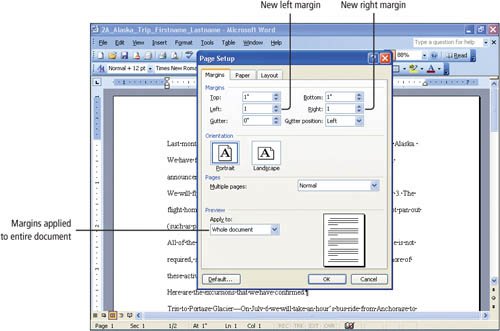
The new margins will be applied to the entire document. |
|
8. |
In the lower right corner of the dialog box, click OK to apply the new margins and close the dialog box. If the ruler below the Formatting toolbar is not displayed, from the View menu, click Ruler. Compare your screen with Figure 2.3. Figure 2.3. (This item is displayed on page 320 in the print version) 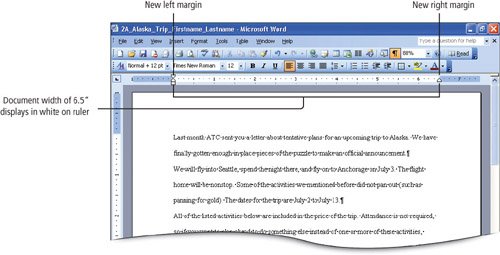
The width of the document is displayed on the ruler. With 1" left and right margins, and using paper that is 8.5" wide, the lines of text within the document will be 6.5". |
|
|
|
|
9. |
From the View menu, display the Header and Footer toolbar. Click the Switch Between Header and Footer button |
Activity 2.2. Aligning Text
Alignment is the placement of paragraph text relative to the left and right margins. Most paragraph text uses left alignmentaligned at the left margin, leaving the right margin uneven. Three other types of paragraph alignment are available: center alignment, which is centered between the left and right margin, right alignment, which is aligned on the right margin, and justified alignment, which is text aligned on both the left and right margins. Examples are shown in the table in Figure 2.4.
|
Alignment |
Button |
Description and Example |
|---|---|---|
|
Align Left |
|
|
|
Center |
|
|
|
Align Right |
|
|
|
Justify |
|
|
|
1. |
Press |
|
2. |
Click to place the insertion point anywhere in the first line of the documentin the line The Alumni Travel Club. On the Formatting toolbar, click the Center button |
|
3. |
Click to place the insertion point anywhere in the second line of the document. On the Formatting toolbar, click the Center button Figure 2.5. 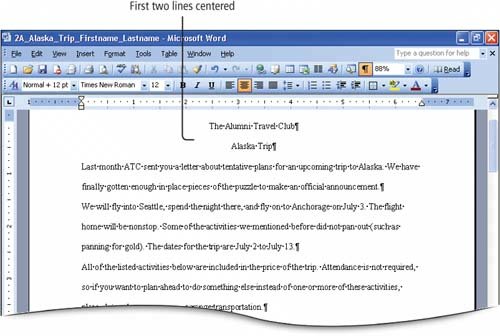
|
|
4. |
Move the pointer into the left margin area, just to the left of the third line of text that begins Last Month, until the |
|
5. |
On the Formatting toolbar, click the Justify button Figure 2.6. (This item is displayed on page 323 in the print version) 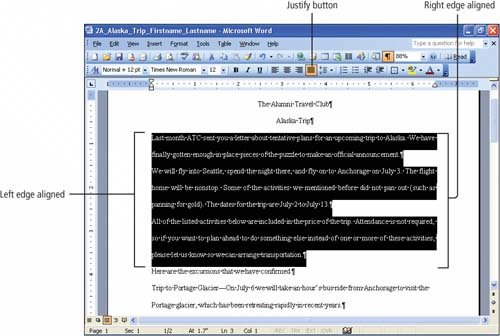
Both the left and right edges of the paragraph are even. The other paragraphs are not affected. |
|
|
|
|
6. |
Because justified text is better used in narrow columns, with the text still selected, on the Formatting toolbar, click the Align Left button |
Activity 2.3. Changing Line Spacing
Line spacing is the distance between lines of text in a paragraph. A single-spaced paragraph of 12-point text accommodates six lines in a vertical inch. If you double-space the same text, each line will be 24 points high (12 points of text, 12 points of space), and will accommodate only three lines in a vertical inch as shown in the table in Figure 2.7.
|
Spacing |
Example |
|---|---|
|
Single (1.0) |
|
|
Double (2.0) |
|
|
1. |
In the left margin area, point to the first line of textthe first title lineto display the |
|
2. |
On the Formatting toolbar, click the Line Spacing button arrow Figure 2.8. 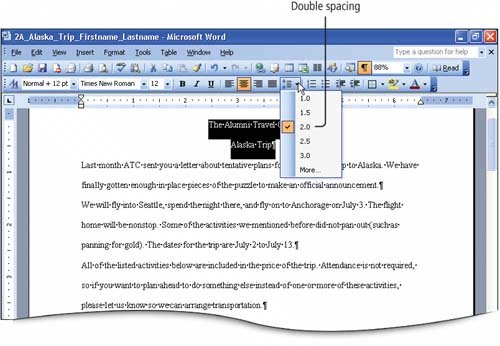
A check mark next to 2.0 indicates that the selected paragraphs are double spaced. |
|
3. |
On the Line Spacing list, click 1.0. |
|
4. |
Click to place the insertion point anywhere in the paragraph that begins Last month ATC sent you. On the Formatting toolbar, click the Line Spacing button arrow |
|
|
|
|
5. |
Click to place the insertion point anywhere in the paragraph that begins We will fly into Seattle. On the Formatting toolbar, point to, but do not click, the Line Spacing button |
|
6. |
On the Formatting toolbar, click the Line Spacing button Figure 2.9. 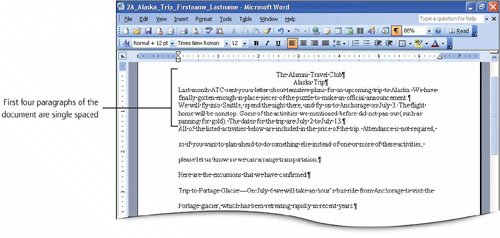
The first four paragraphs of the document are single spaced. Recall that each title line is a paragrapha paragraph is any text followed by a paragraph mark. |
|
7. |
Save |
Activity 2.4. Adding Space After Paragraphs
Adjusting paragraph spacing from the Paragraph dialog box enables you to control the space before or after paragraphs using points as the unit of measure. Recall that there are 72 points per inch.
|
1. |
Press |
|
2. |
In the Paragraph dialog box, click the Indents and Spacing tab. Under Spacing, in the After spin box, click the up spin arrow two times, and then compare your screen with Figure 2.10. Figure 2.10. 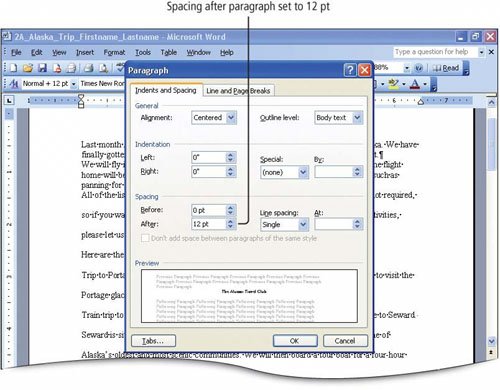
The value in the box changes from 0 pt to 12 pt. A spin box is a small box with an upward- and downward-pointing arrow that lets you move (spin) through a set of values by clicking. The up and down arrows, called spin box arrows, increment the point size by six points at a time. Alternatively, type a number of your choice directly into the spin box. |
|
3. |
Click OK to add a 12 pt space after the paragraph. |
|
4. |
In the Alaska Trip paragraph, click to position the insertion point anywhere in the paragraph. From the Format menu, display the Paragraph dialog box. Under Spacing, in the After box, click the up spin arrow one time to change the value in the box from 0 pt to 6 pt. Click OK. |
|
5. |
In the left margin area, point to |
|
6. |
From the Format menu, display the Paragraph dialog box. Under Spacing, set After to 6 pt, and then click OK. Click anywhere to deselect the text, and then compare your screen with Figure 2.11. Figure 2.11. 
|
|
7. |
Save |
Activity 2.5. Indenting Paragraphs
In addition to adding space at the end of paragraphs, indentingmoving the beginning of the first line of a paragraph to the right or left of the rest of the paragraphprovides visual cues to the reader to help break the document up and make it easier to read.
|
1. |
In the paragraph that begins Last month ATC sent you, click to position the insertion point. From the Format menu, display the Paragraph dialog box, and then click the Indents and Spacing tab. Under Indentation, click the Special arrow, and then from the displayed list, click First line. |
|
2. |
Under Indentation, in the By box, be sure 0.5" displays as shown in Figure 2.12. Figure 2.12. 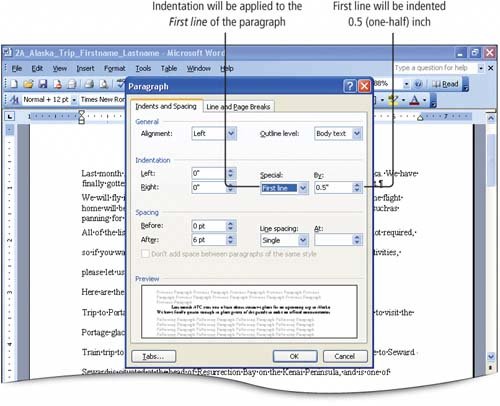
|
|
3. |
In the lower right corner of the dialog box, click OK. On the ruler, notice that the First Line Indent marker moved to the 0.5 inch mark. |
|
4. |
In the paragraph that begins We will fly into Seattle, click to position the insertion point. Using the technique you just practiced, set the first line of the paragraph to indent 0.5 inch, and then compare your screen with Figure 2.13. Figure 2.13. 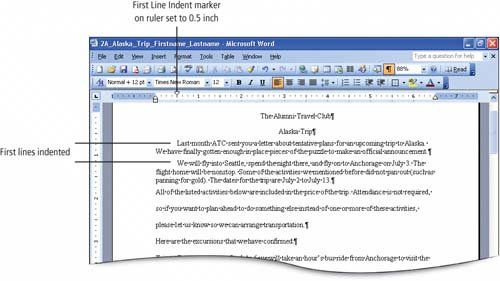
|
|
|
|
|
5. |
Save |
Activity 2.6. Using the Format Painter
Use the Format Painter to copy the formatting of specific text or of a paragraph and then apply it in other locations in your document.
|
1. |
Click anywhere in the paragraph that begins Last month ATC sent you. On the Standard toolbar, click the Format Painter button Figure 2.14. 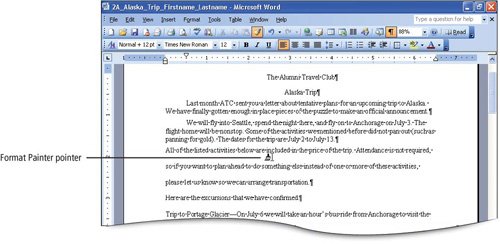
The pointer takes the shape of a paintbrush, and contains the formatting information from the paragraph where the insertion point is positioned. |
|
2. |
Click one time. |
|
3. |
On the Standard toolbar, double-click the Format Painter button |
|
4. |
Using the down scroll arrow, scroll to view the top of Page 2, and then move the pointer over the paragraph that begins As we mentioned. Click one time. |
|
|
|
|
5. |
Scroll down and click one time in each of the two remaining paragraphs in the document, and then compare your document with Figure 2.15. Figure 2.15. 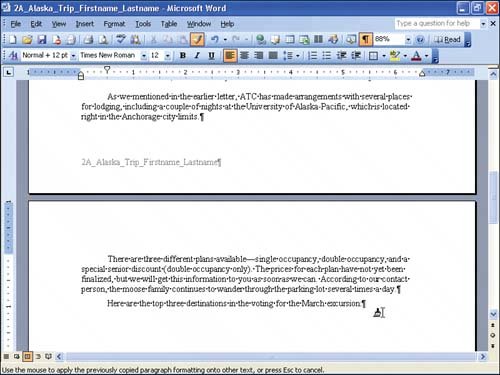
Using the Format Painter to copy formatting that you have set in one paragraph is much faster than clicking in each paragraph, opening the Paragraph dialog box, and resetting the indentation and spacing for each paragraph individually. |
|
6. |
On the Standard toolbar, click the Format Painter button |
|
[Page 330 (continued)] Objective 2 Change and Reorganize Text |
Windows XP
- Chapter One. Getting Started with Windows XP
- Project 1A. Windows XP
- Objective 1. Get Started with Windows XP
- Objective 2. Resize, Move, and Scroll Windows
- Objective 3. Maximize, Restore, Minimize, and Close a Window
- Objective 4. Create a New Folder
- Objective 5. Copy, Move, Rename, and Delete Files
- Objective 6. Find Files and Folders
- Objective 7. Compress Files
- Summary
- Key Terms
- Concepts Assessments
Outlook 2003
- Chapter One. Getting Started with Outlook 2003
- Getting Started with Microsoft Office Outlook 2003
- Project 1A. Exploring Outlook 2003
- Objective 1. Start and Navigate Outlook
- Objective 2. Read and Respond to E-mail
- Objective 3. Store Contact and Task Information
- Objective 4. Work with the Calendar
- Objective 5. Delete Outlook Information and Close Outlook
- Summary
- Key Terms
- Concepts Assessments
- Skill Assessments
- Performance Assessments
- Mastery Assessments
- Problem Solving
- GO! with Help
Internet Explorer
- Chapter One. Getting Started with Internet Explorer
- Getting Started with Internet Explorer 6.0
- Project 1A. College and Career Information
- Objective 1. Start Internet Explorer and Identify Screen Elements
- Objective 2. Navigate the Internet
- Objective 3. Create and Manage Favorites
- Objective 4. Search the Internet
- Objective 5. Save and Print Web Pages
- Summary
- Key Terms
- Concepts Assessments
- Skill Assessments
- Performance Assessments
- Mastery Assessments
- Problem Solving
Computer Concepts
- Chapter One. Basic Computer Concepts
- Objective 1. Define Computer and Identify the Four Basic Computing Functions
- Objective 2. Identify the Different Types of Computers
- Objective 3. Describe Hardware Devices and Their Uses
- Objective 4. Identify Types of Software and Their Uses
- Objective 5. Describe Networks and Define Network Terms
- Objective 6. Identify Safe Computing Practices
- Summary
- In this Chapter You Learned How to
- Key Terms
- Concepts Assessments
Word 2003
Chapter One. Creating Documents with Microsoft Word 2003
- Chapter One. Creating Documents with Microsoft Word 2003
- Getting Started with Microsoft Office Word 2003
- Project 1A. Thank You Letter
- Objective 1. Create and Save a New Document
- Objective 2. Edit Text
- Objective 3. Select, Delete, and Format Text
- Objective 4. Create Footers and Print Documents
- Project 1B. Party Themes
- Objective 5. Navigate the Word Window
- Objective 6. Add a Graphic to a Document
- Objective 7. Use the Spelling and Grammar Checker
- Objective 8. Preview and Print Documents, Close a Document, and Close Word
- Objective 9. Use the Microsoft Help System
- Summary
- Key Terms
- Concepts Assessments
- Skill Assessments
- Performance Assessments
- Mastery Assessments
- Problem Solving
- You and GO!
- Business Running Case
- GO! with Help
Chapter Two. Formatting and Organizing Text
- Formatting and Organizing Text
- Project 2A. Alaska Trip
- Objective 1. Change Document and Paragraph Layout
- Objective 2. Change and Reorganize Text
- Objective 3. Create and Modify Lists
- Project 2B. Research Paper
- Objective 4. Insert and Format Headers and Footers
- Objective 5. Insert Frequently Used Text
- Objective 6. Insert and Format References
- Summary
- Key Terms
- Concepts Assessments
- Skill Assessments
- Performance Assessments
- Mastery Assessments
- Problem Solving
- You and GO!
- Business Running Case
- GO! with Help
Chapter Three. Using Graphics and Tables
- Using Graphics and Tables
- Project 3A. Job Opportunities
- Objective 1. Insert and Modify Clip Art and Pictures
- Objective 2. Use the Drawing Toolbar
- Project 3B. Park Changes
- Objective 3. Set Tab Stops
- Objective 4. Create a Table
- Objective 5. Format a Table
- Objective 6. Create a Table from Existing Text
- Summary
- Key Terms
- Concepts Assessments
- Skill Assessments
- Performance Assessments
- Mastery Assessments
- Problem Solving
- You and GO!
- Business Running Case
- GO! with Help
Chapter Four. Using Special Document Formats, Columns, and Mail Merge
- Using Special Document Formats, Columns, and Mail Merge
- Project 4A. Garden Newsletter
- Objective 1. Create a Decorative Title
- Objective 2. Create Multicolumn Documents
- Objective 3. Add Special Paragraph Formatting
- Objective 4. Use Special Character Formats
- Project 4B. Water Matters
- Objective 5. Insert Hyperlinks
- Objective 6. Preview and Save a Document as a Web Page
- Project 4C. Recreation Ideas
- Objective 7. Locate Supporting Information
- Objective 8. Find Objects with the Select Browse Object Button
- Project 4D. Mailing Labels
- Objective 9. Create Labels Using the Mail Merge Wizard
- Summary
- Key Terms
- Concepts Assessments
- Skill Assessments
- Performance Assessments
- Mastery Assessments
- Problem Solving
- You and GO!
- Business Running Case
- GO! with Help
Excel 2003
Chapter One. Creating a Worksheet and Charting Data
- Creating a Worksheet and Charting Data
- Project 1A. Tableware
- Objective 1. Start Excel and Navigate a Workbook
- Objective 2. Select Parts of a Worksheet
- Objective 3. Enter and Edit Data in a Worksheet
- Objective 4. Construct a Formula and Use the Sum Function
- Objective 5. Format Data and Cells
- Objective 6. Chart Data
- Objective 7. Annotate a Chart
- Objective 8. Prepare a Worksheet for Printing
- Objective 9. Use the Excel Help System
- Project 1B. Gas Usage
- Objective 10. Open and Save an Existing Workbook
- Objective 11. Navigate and Rename Worksheets
- Objective 12. Enter Dates and Clear Formats
- Objective 13. Use a Summary Sheet
- Objective 14. Format Worksheets in a Workbook
- Summary
- Key Terms
- Concepts Assessments
- Skill Assessments
- Performance Assessments
- Mastery Assessments
- Problem Solving
- You and GO!
- Business Running Case
- GO! with Help
Chapter Two. Designing Effective Worksheets
- Designing Effective Worksheets
- Project 2A. Staff Schedule
- Objective 1. Use AutoFill to Fill a Pattern of Column and Row Titles
- Objective 2. Copy Text Using the Fill Handle
- Objective 3. Use AutoFormat
- Objective 4. View, Scroll, and Print Large Worksheets
- Project 2B. Inventory Value
- Objective 5. Design a Worksheet
- Objective 6. Copy Formulas
- Objective 7. Format Percents, Move Formulas, and Wrap Text
- Objective 8. Make Comparisons Using a Pie Chart
- Objective 9. Print a Chart on a Separate Worksheet
- Project 2C. Population Growth
- Objective 10. Design a Worksheet for What-If Analysis
- Objective 11. Perform What-If Analysis
- Objective 12. Compare Data with a Line Chart
- Summary
- Key Terms
- Concepts Assessments
- Skill Assessments
- Performance Assessments
- Mastery Assessments
- Problem Solving
- You and GO!
- Business Running Case
- GO! with Help
Chapter Three. Using Functions and Data Tables
- Using Functions and Data Tables
- Project 3A. Geography Lecture
- Objective 1. Use SUM, AVERAGE, MIN, and MAX Functions
- Objective 2. Use a Chart to Make Comparisons
- Project 3B. Lab Supervisors
- Objective 3. Use COUNTIF and IF Functions, and Apply Conditional Formatting
- Objective 4. Use a Date Function
- Project 3C. Loan Payment
- Objective 5. Use Financial Functions
- Objective 6. Use Goal Seek
- Objective 7. Create a Data Table
- Summary
- Key Terms
- Concepts Assessments
- Skill Assessments
- Performance Assessments
- Mastery Assessments
- Problem Solving
- You and GO!
- Business Running Case
- GO! with Help
Access 2003
Chapter One. Getting Started with Access Databases and Tables
- Getting Started with Access Databases and Tables
- Project 1A. Academic Departments
- Objective 1. Rename a Database
- Objective 2. Start Access, Open an Existing Database, and View Database Objects
- Project 1B. Fundraising
- Objective 3. Create a New Database
- Objective 4. Create a New Table
- Objective 5. Add Records to a Table
- Objective 6. Modify the Table Design
- Objective 7. Create Table Relationships
- Objective 8. Find and Edit Records in a Table
- Objective 9. Print a Table
- Objective 10. Close and Save a Database
- Objective 11. Use the Access Help System
- Summary
- Key Terms
- Concepts Assessments
- Skill Assessments
- Performance Assessments
- Mastery Assessments
- Problem Solving Assessments
- Problem Solving
- You and GO!
- Business Running Case
- GO! with Help
Chapter Two. Sort, Filter, and Query a Database
- Sort, Filter, and Query a Database
- Project 2A. Club Fundraiser
- Objective 1. Sort Records
- Objective 2. Filter Records
- Objective 3. Create a Select Query
- Objective 4. Open and Edit an Existing Query
- Objective 5. Sort Data in a Query
- Objective 6. Specify Text Criteria in a Query
- Objective 7. Print a Query
- Objective 8. Specify Numeric Criteria in a Query
- Objective 9. Use Compound Criteria
- Objective 10. Create a Query Based on More Than One Table
- Objective 11. Use Wildcards in a Query
- Objective 12. Use Calculated Fields in a Query
- Objective 13. Group Data and Calculate Statistics in a Query
- Summary
- Key Terms
- Concepts Assessments
- Skill Assessments
- Performance Assessments
- Mastery Assessments
- Problem Solving
- You and GO!
- Business Running Case
- GO! with Access Help
Chapter Three. Forms and Reports
- Forms and Reports
- Project 3A. Fundraiser
- Objective 1. Create an AutoForm
- Objective 2. Use a Form to Add and Delete Records
- Objective 3. Create a Form Using the Form Wizard
- Objective 4. Modify a Form
- Objective 5. Create an AutoReport
- Objective 6. Create a Report Using the Report Wizard
- Objective 7. Modify the Design of a Report
- Objective 8. Print a Report and Keep Data Together
- Summary
- Key Terms
- Concepts Assessments
- Skill Assessments
- Performance Assessments
- Mastery Assessments
- Problem Solving
- You and GO!
- Business Running Case
- GO! with Help
Powerpoint 2003
Chapter One. Getting Started with PowerPoint 2003
- Getting Started with PowerPoint 2003
- Project 1A. Expansion
- Objective 1. Start and Exit PowerPoint
- Objective 2. Edit a Presentation Using the Outline/Slides Pane
- Objective 3. Format and Edit a Presentation Using the Slide Pane
- Objective 4. View and Edit a Presentation in Slide Sorter View
- Objective 5. View a Slide Show
- Objective 6. Create Headers and Footers
- Objective 7. Print a Presentation
- Objective 8. Use PowerPoint Help
- Summary
- Key Terms
- Concepts Assessments
- Skill Assessments
- Performance Assessments
- Mastery Assessments
- Problem Solving
- You and GO!
- Business Running Case
- GO! with Help
Chapter Two. Creating a Presentation
- Creating a Presentation
- Project 2A. Teenagers
- Objective 1. Create a Presentation
- Objective 2. Modify Slides
- Project 2B. History
- Objective 3. Create a Presentation Using a Design Template
- Objective 4. Import Text from Word
- Objective 5. Move and Copy Text
- Summary
- Key Terms
- Concepts Assessments
- Skill Assessments
- Performance Assessments
- Mastery Assessments
- Problem Solving
- You and GO!
- Business Running Case
- GO! with Help
Chapter Three. Formatting a Presentation
- Project 3A. Emergency
- Objective 1. Format Slide Text
- Objective 2. Modify Placeholders
- Objective 3. Modify Slide Master Elements
- Objective 4. Insert Clip Art
- Project 3B. Volunteers
- Objective 5. Apply Bullets and Numbering
- Objective 6. Customize a Color Scheme
- Objective 7. Modify the Slide Background
- Objective 8. Apply an Animation Scheme
- Summary
- Key Terms
- Concepts Assessments
- Skill Assessments
- Performance Assessments
- Mastery Assessments
- Problem Solving
- You and GO!
- Business Running Case
- GO! with Help
Integrated Projects
Chapter One. Using Access Data with Other Office Applications
- Chapter One. Using Access Data with Other Office Applications
- Introduction
- Project 1A. Meeting Slides
- Objective 1. Export Access Data to Excel
- Objective 2. Create a Formula in Excel
- Objective 3. Create a Chart in Excel
- Objective 4. Copy Access Data into a Word Document
- Objective 5. Copy Excel Data into a Word Document
- Objective 6. Insert an Excel Chart into a PowerPoint Presentation
Chapter Two. Using Tables in Word and Excel
- Chapter Two. Using Tables in Word and Excel
- Introduction
- Project 2A. Meeting Notes
- Objective 1. Plan a Table in Word
- Objective 2. Enter Data and Format a Table in Word
- Objective 3. Create a Table in Word from Excel Data
- Objective 4. Create Excel Worksheet Data from a Word Table
Chapter Three. Using Excel as a Data Source in a Mail Merge
- Chapter Three. Using Excel as a Data Source in a Mail Merge
- Introduction
- Project 3A. Mailing Labels
- Objective 1. Prepare a Mail Merge Document as Mailing Labels
- Objective 2. Choose an Excel Worksheet as a Data Source
- Objective 3. Produce and Save Merged Mailing Labels
- Objective 4. Open a Saved Main Document for Mail Merge
Chapter Four. Linking Data in Office Documents
- Chapter Four. Linking Data in Office Documents
- Introduction
- Project 4A. Weekly Sales
- Objective 1. Insert and Link in Word an Excel Object
- Objective 2. Format an Object in Word
- Objective 3. Open a Word Document That Includes a Linked Object, and Update Links
Chapter Five. Creating Presentation Content from Office Documents
EAN: 2147483647
Pages: 448
 , and then navigate to the location where the student files for this textbook are stored. Locate and click once to select w02A_Alaska_Trip, and then, in the lower right corner of the Open dialog box, click Open.
, and then navigate to the location where the student files for this textbook are stored. Locate and click once to select w02A_Alaska_Trip, and then, in the lower right corner of the Open dialog box, click Open. . In the Name box, name the new folder Word Chapter 2 and then click OK.
. In the Name box, name the new folder Word Chapter 2 and then click OK. to move the insertion point to the beginning of the document. On the Formatting toolbar, click the Spelling and
to move the insertion point to the beginning of the document. On the Formatting toolbar, click the Spelling and . For each identified spelling or grammar error, click either Ignore All or Ignore Rule.
. For each identified spelling or grammar error, click either Ignore All or Ignore Rule. to display the formatting marks on your screen. Click the Zoom button arrow
to display the formatting marks on your screen. Click the Zoom button arrow  , and from the list, click Page Width.
, and from the list, click Page Width. as necessary to select the value in the Left box, and then with 1.25" selected, type 1
as necessary to select the value in the Left box, and then with 1.25" selected, type 1 , click Insert AutoText
, click Insert AutoText  , and from the displayed list, click Filename. On the Header and Footer toolbar, click the Close button
, and from the displayed list, click Filename. On the Header and Footer toolbar, click the Close button  . Save
. Save  the changes you have made to your document.
the changes you have made to your document.







 . Type Alaska Trip and press
. Type Alaska Trip and press  pointer displays. Then, drag down to select this line of text and the next seven lines of textincluding the line that begins please let us know.
pointer displays. Then, drag down to select this line of text and the next seven lines of textincluding the line that begins please let us know.

 , and then compare your screen with Figure 2.8.
, and then compare your screen with Figure 2.8. . Point to the paragraph that begins All of the listed activities, and then compare your screen with Figure 2.14.
. Point to the paragraph that begins All of the listed activities, and then compare your screen with Figure 2.14. .
. . Save
. Save 